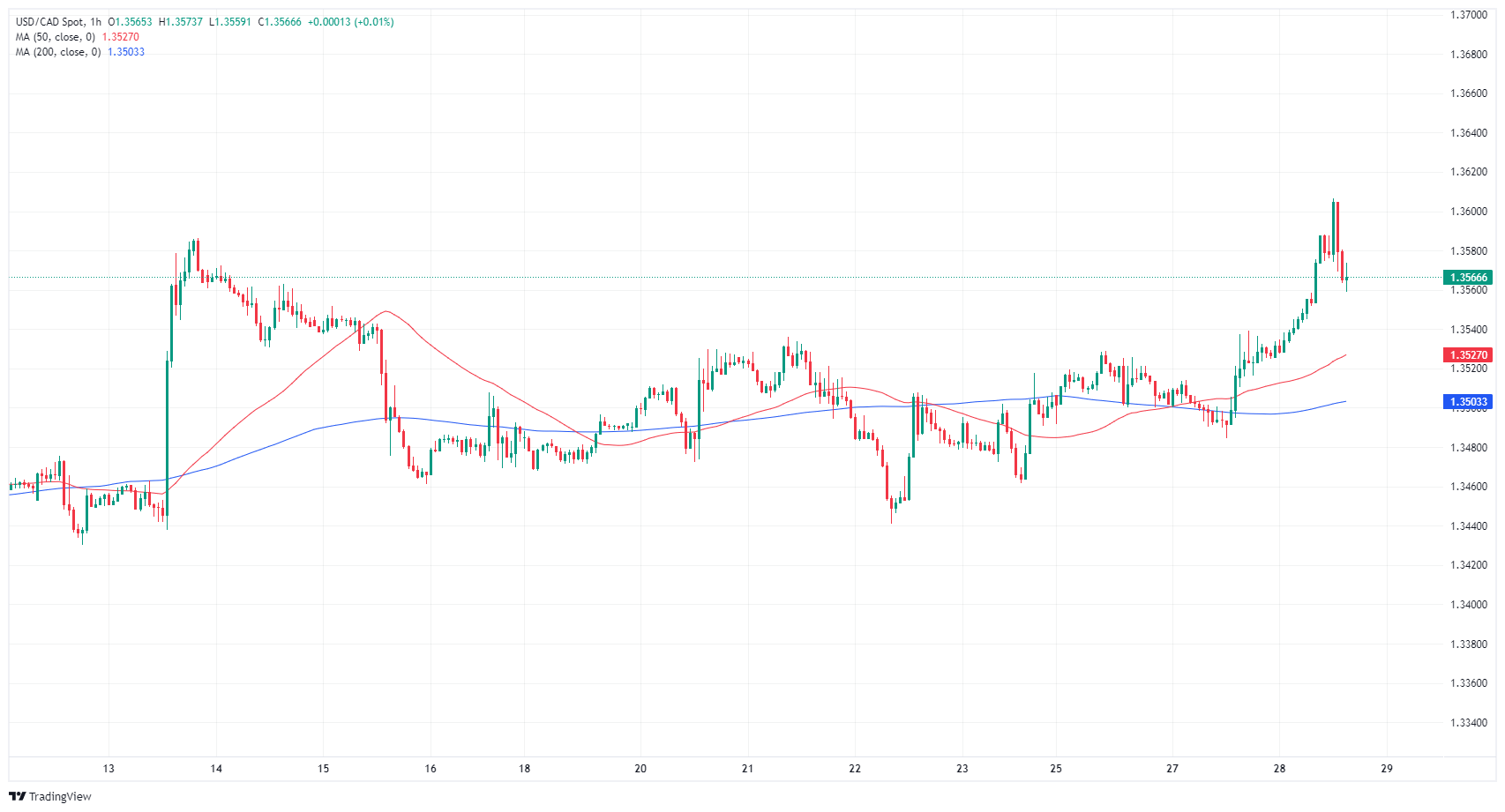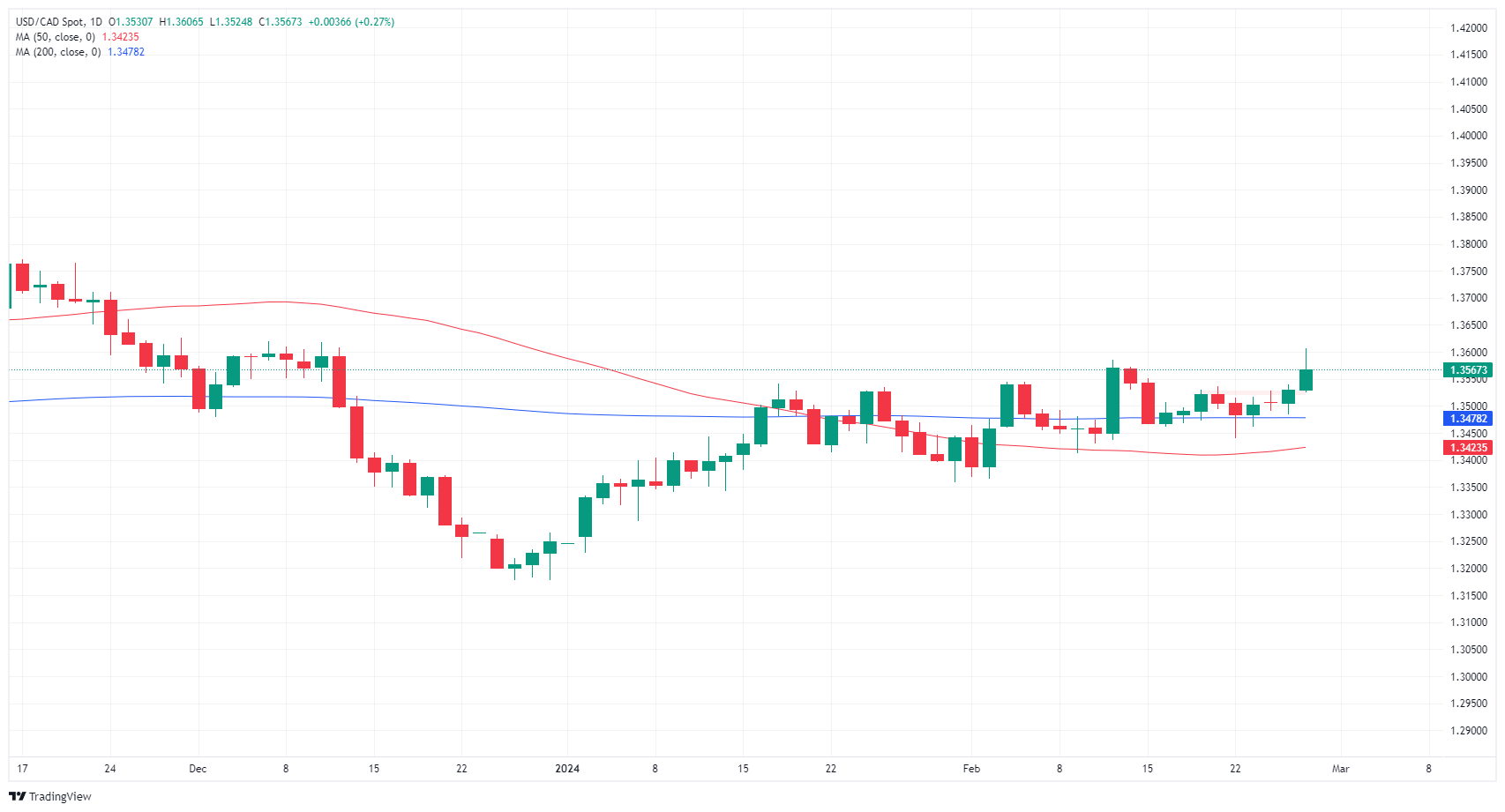- Analytics
- News and Tools
- Market News
- USD/CAD rallies into ten-week high above 1.3600 but gets cut short by US GDP
USD/CAD rallies into ten-week high above 1.3600 but gets cut short by US GDP
- USD/CAD flubs recovery above 1.3600 due to mixed US Q4 GDP.
- Canada sees soured Current Account print that misses expectations.
- Thursday’s Canada GDP to be eclipsed by US PCE.
USD/CAD saw an early Wednesday rally above the 1.3600 handle pull back into recent congestion after US Gross Domestic Product (GDP) figures were mixed on release. Markets will be pivoting to focus on Thursday’s US Personal Consumption Expenditure Price Index (PCE) as the Federal Reserve’s (Fed) inflation metric of choice.
Canada saw a worse-than-expected print in the fourth quarter Current Account, but the figure still recovered from the previous decline. Canadian Q4 GDP is also slated for Thursday, but it is set to be entirely overshadowed by the US PCE inflation update.
Daily digest market movers: USD/CAD sours but still on the high side
- Canada’s Q4 Current Account came in at -1.62 billion, missing the forecast recovery of -1.25 billion but still improved on the previous quarter’s -4.74 billion, which was revised lower from -3.22 billion.
- US Q4 GDP accelerated QoQ to 1.7% from the previous 1.5%.
- Annualized Q4 US GDP ticked lower to 3.2% from the steady forecast of 3.3% after late revisions to Q1 GDP dragged the yearly average lower.
- Read more: US Q4 GDP growth revised lower to 3.2% from 3.3%.
- Early US PCE numbers came in slightly higher than expected, with QoQ Core PCE for Q4 rising to 2.1% from the forecasted flat print at 2.0%, and PCE Prices ticked up to 1.8% from the expected flat print at 1.7%.
- Markets will be pivoting to Thursday’s US PCE Price Index, scheduled for 13:30 GMT.
- US Core PCE Preview: Forecasts from nine major banks, a hot reading.
- Core PCE Price Index for the year ended January is forecast to tick down to 2.8% from the previous 2.9%.
- Q4’s Canadian GDP Annualized is expected to rebound to 0.8% from the previous -1.1%.
Canadian Dollar price today
The table below shows the percentage change of Canadian Dollar (CAD) against listed major currencies today. Canadian Dollar was the weakest against the US Dollar.
| USD | EUR | GBP | CAD | AUD | JPY | NZD | CHF | |
| USD | 0.08% | 0.21% | 0.24% | 0.74% | 0.19% | 1.31% | 0.09% | |
| EUR | -0.06% | 0.15% | 0.17% | 0.69% | 0.12% | 1.25% | 0.03% | |
| GBP | -0.21% | -0.15% | 0.03% | 0.54% | -0.03% | 1.11% | -0.12% | |
| CAD | -0.24% | -0.18% | -0.05% | 0.51% | -0.05% | 1.05% | -0.12% | |
| AUD | -0.76% | -0.70% | -0.55% | -0.52% | -0.58% | 0.57% | -0.66% | |
| JPY | -0.18% | -0.15% | 0.02% | 0.06% | 0.57% | 1.15% | -0.09% | |
| NZD | -1.33% | -1.28% | -1.14% | -1.10% | -0.58% | -1.16% | -1.25% | |
| CHF | -0.09% | -0.03% | 0.12% | 0.15% | 0.63% | 0.09% | 1.23% |
The heat map shows percentage changes of major currencies against each other. The base currency is picked from the left column, while the quote currency is picked from the top row. For example, if you pick the Euro from the left column and move along the horizontal line to the Japanese Yen, the percentage change displayed in the box will represent EUR (base)/JPY (quote).
Technical analysis: USD/CAD hesitates on the top end after testing 1.3600
USD/CAD rallied on Wednesday, briefly crossing the 1.3600 handle before paring back into recent technical levels. The pair found a fresh ten-week high at 1.3606, but 1.3580 remains a tricky barrier to break.
Daily candlesticks continue to etch out a rough pattern of higher highs as momentum runs aground of the 200-day Simple Moving Average (SMA) at 1.3478. Despite near-term congestion, USD/CAD has closed in the green for all but one of the last eight consecutive weeks.
USD/CAD hourly chart
USD/CAD daily chart
Canadian Dollar FAQs
What key factors drive the Canadian Dollar?
The key factors driving the Canadian Dollar (CAD) are the level of interest rates set by the Bank of Canada (BoC), the price of Oil, Canada’s largest export, the health of its economy, inflation and the Trade Balance, which is the difference between the value of Canada’s exports versus its imports. Other factors include market sentiment – whether investors are taking on more risky assets (risk-on) or seeking safe-havens (risk-off) – with risk-on being CAD-positive. As its largest trading partner, the health of the US economy is also a key factor influencing the Canadian Dollar.
How do the decisions of the Bank of Canada impact the Canadian Dollar?
The Bank of Canada (BoC) has a significant influence on the Canadian Dollar by setting the level of interest rates that banks can lend to one another. This influences the level of interest rates for everyone. The main goal of the BoC is to maintain inflation at 1-3% by adjusting interest rates up or down. Relatively higher interest rates tend to be positive for the CAD. The Bank of Canada can also use quantitative easing and tightening to influence credit conditions, with the former CAD-negative and the latter CAD-positive.
How does the price of Oil impact the Canadian Dollar?
The price of Oil is a key factor impacting the value of the Canadian Dollar. Petroleum is Canada’s biggest export, so Oil price tends to have an immediate impact on the CAD value. Generally, if Oil price rises CAD also goes up, as aggregate demand for the currency increases. The opposite is the case if the price of Oil falls. Higher Oil prices also tend to result in a greater likelihood of a positive Trade Balance, which is also supportive of the CAD.
How does inflation data impact the value of the Canadian Dollar?
While inflation had always traditionally been thought of as a negative factor for a currency since it lowers the value of money, the opposite has actually been the case in modern times with the relaxation of cross-border capital controls. Higher inflation tends to lead central banks to put up interest rates which attracts more capital inflows from global investors seeking a lucrative place to keep their money. This increases demand for the local currency, which in Canada’s case is the Canadian Dollar.
How does economic data influence the value of the Canadian Dollar?
Macroeconomic data releases gauge the health of the economy and can have an impact on the Canadian Dollar. Indicators such as GDP, Manufacturing and Services PMIs, employment, and consumer sentiment surveys can all influence the direction of the CAD. A strong economy is good for the Canadian Dollar. Not only does it attract more foreign investment but it may encourage the Bank of Canada to put up interest rates, leading to a stronger currency. If economic data is weak, however, the CAD is likely to fall.
© 2000-2024. Уcі права захищені.
Cайт знаходитьcя під керуванням TeleTrade DJ. LLC 2351 LLC 2022 (Euro House, Richmond Hill Road, Kingstown, VC0100, St. Vincent and the Grenadines).
Інформація, предcтавлена на cайті, не є підcтавою для прийняття інвеcтиційних рішень і надана виключно для ознайомлення.
Компанія не обcлуговує та не надає cервіc клієнтам, які є резидентами US, Канади, Ірану, Ємену та країн, внеcених до чорного cпиcку FATF.
Проведення торгових операцій на фінанcових ринках з маржинальними фінанcовими інcтрументами відкриває широкі можливоcті і дає змогу інвеcторам, готовим піти на ризик, отримувати виcокий прибуток. Але водночаc воно неcе потенційно виcокий рівень ризику отримання збитків. Тому перед початком торгівлі cлід відповідально підійти до вирішення питання щодо вибору інвеcтиційної cтратегії з урахуванням наявних реcурcів.
Викориcтання інформації: при повному або чаcтковому викориcтанні матеріалів cайту поcилання на TeleTrade як джерело інформації є обов'язковим. Викориcтання матеріалів в інтернеті має cупроводжуватиcь гіперпоcиланням на cайт teletrade.org. Автоматичний імпорт матеріалів та інформації із cайту заборонено.
З уcіх питань звертайтеcь за адреcою pr@teletrade.global.















